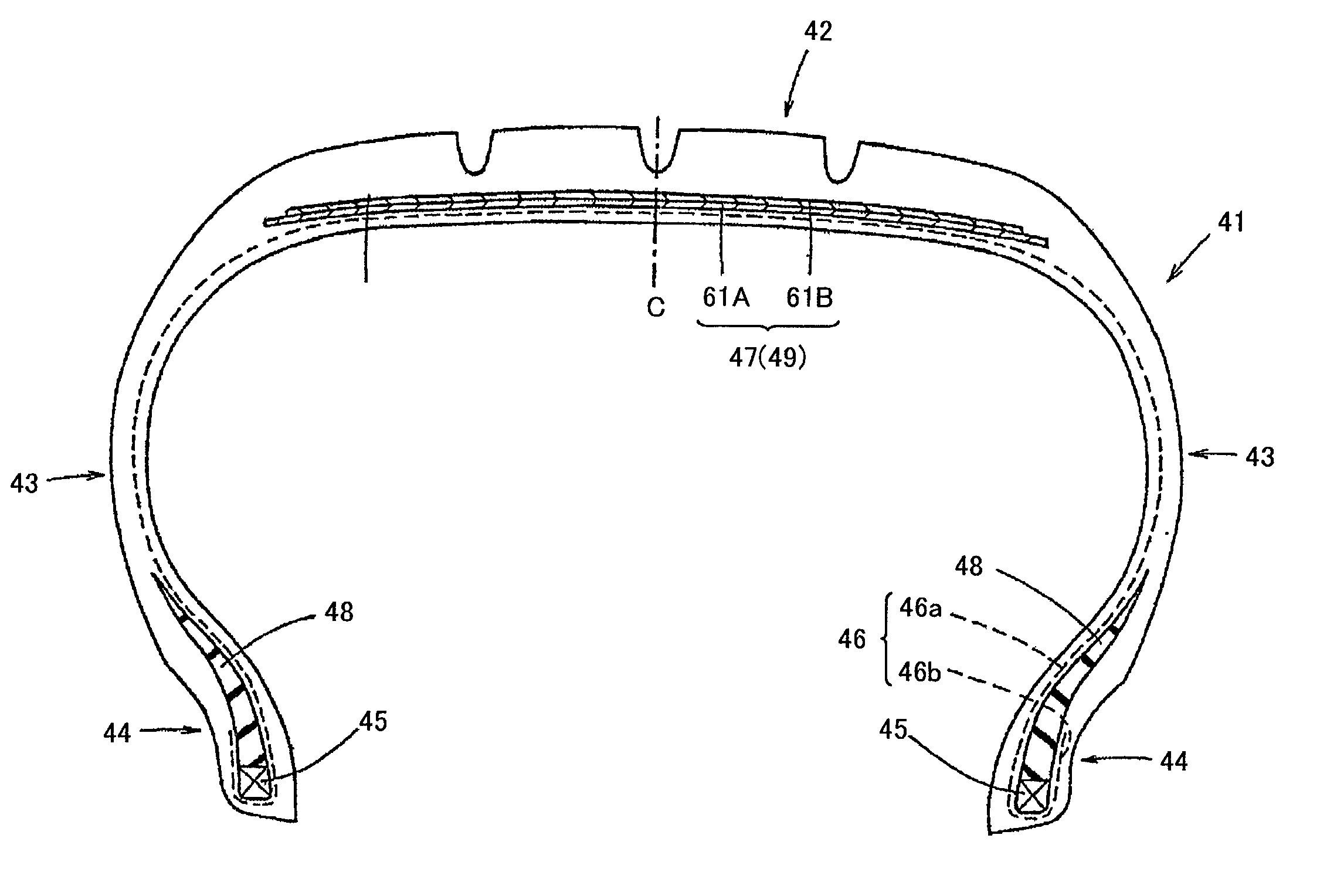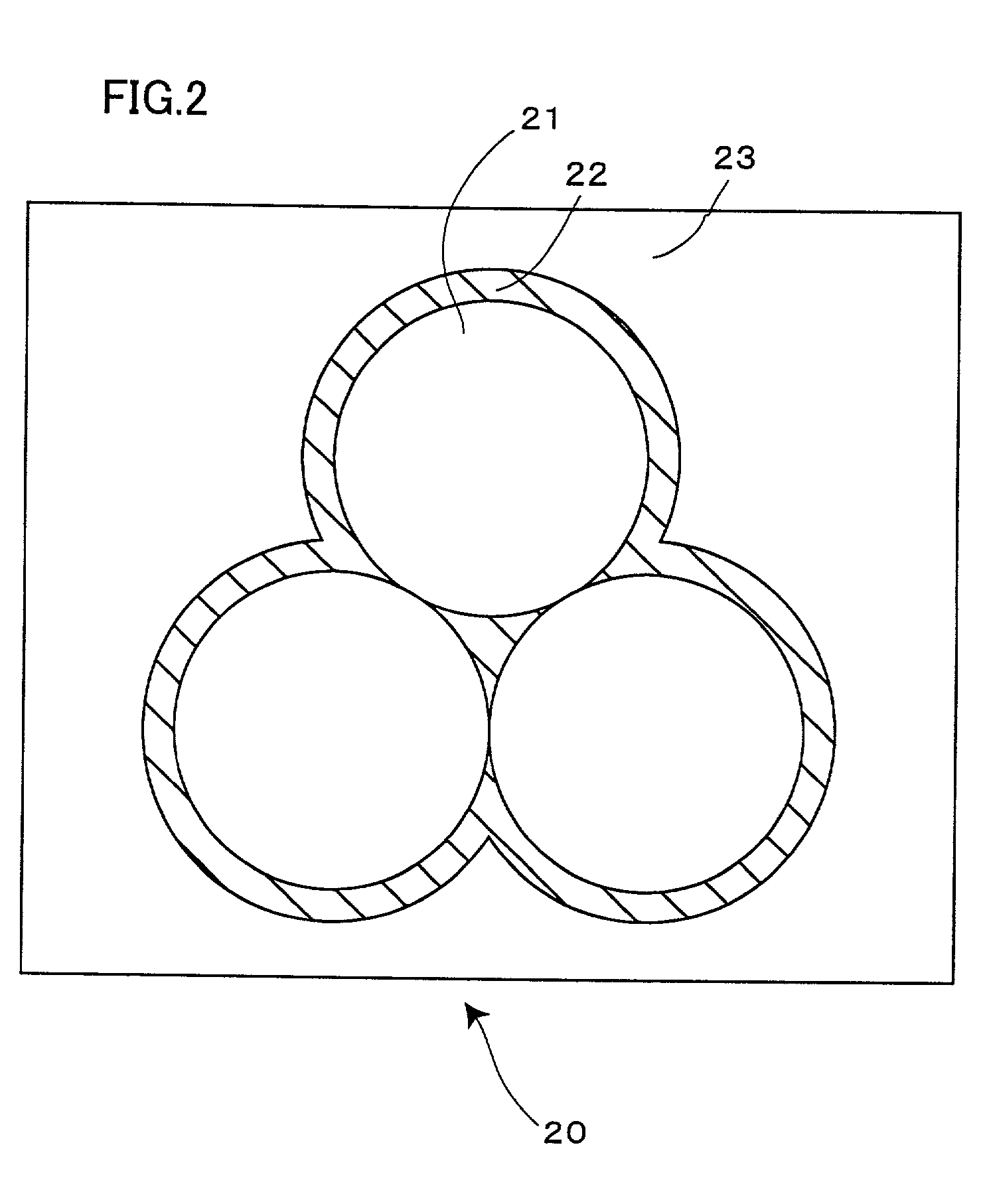Composite of steel cord and rubber composition and tire using the same
a technology of rubber composition and composite material, which is applied in the direction of tyre beads, transportation and packaging, and other domestic objects, can solve the problems of difficult to apply this method to tires, tire failure, and inferior adhesion to aging
- Summary
- Abstract
- Description
- Claims
- Application Information
AI Technical Summary
Benefits of technology
Problems solved by technology
Method used
Image
Examples
example 1
[0091] A steel wire that has been drawn to have the diameter of 0.27 mm was plated with brass containing 63 mass % of copper and 37 mass % of zinc, and mineral oil was sprayed thereto. Three steel wires prepared in this manner were twisted to have a cord diameter of 0.58 mm, and thus a steel cord was fabricated.
[0092] The thus fabricated steel cord was dipped in a toluene solution containing 10 mass % of rubber composition of the mixture A listed in Table 1 and dried, providing a composite (composite (I)) of steel cord and rubber composition forming the inner coating layer, in which the thickness of the coating rubber layer was 0.1 to 1.5 mm (average thickness: 0.5 mm).
1TABLE 1 Mixture of Rubber Composition (in parts by weight) Mixture (PHR) Mixture Mixture Mixture Mixture Mixture Mixture Added Agents A B C D E F Natural 100 100 100 100 100 100 Rubber (NR) Carbon Black 60 60 60 60 60 60 (HAF) Zinc White 8 8 8 8 8 8 Anti- 2 2 2 2 2 2 oxidant (*1) Mineral oil 2 2 2 2 2 2 Vulcanization...
example ii
[0102] A composite (composite (IV)) of steel cord and rubber composition forming the inner coating layer was fabricated under the same condition as composite (I), except that the thickness of inner coating layer was 0.05 mm.
[0103] The composite (IV) was coated with the outer coating rubber composition of mixture B shown in Table 1 as a topping, vulcanized at 165.degree. C. for 18 minutes and a sample (IV) for wet-heat adhesion was fabricated in the similar manner as Example 1.
[0104] Further, the composite (IV) was coated with the outer coating rubber composition of mixture B shown in Table 1 as a topping, to have the gauge of 1.15 mm, and thus a belt layer was fabricated. Using the belt layer, a tire (IV) was formed under the condition shown in Table 2.
example 3
[0105] A composite (composite (V)) of steel cord and rubber composition forming the inner coating layer was fabricated under the same condition as composite (I), except that the thickness of the inner coating layer was 2.0 mm.
[0106] The composite (V) was coated with the outer coating rubber composition of mixture B shown in Table 1 as a topping, vulcanized at 165.degree. C. for 18 minutes and, in the similar manner as in Example 1, a sample (V) for wet-heat adhesion was fabricated.
[0107] Further, the composite (V) was coated with the outer coating rubber composition of mixture B shown in Table 1 to have the gauge of 1.15 mm as a topping, and a belt layer was fabricated. Using the belt layer, a tire (V) was formed under the condition shown in Table 2.
PUM
| Property | Measurement | Unit |
|---|---|---|
| thickness | aaaaa | aaaaa |
| specific surface area | aaaaa | aaaaa |
| thickness | aaaaa | aaaaa |
Abstract
Description
Claims
Application Information
 Login to View More
Login to View More - R&D
- Intellectual Property
- Life Sciences
- Materials
- Tech Scout
- Unparalleled Data Quality
- Higher Quality Content
- 60% Fewer Hallucinations
Browse by: Latest US Patents, China's latest patents, Technical Efficacy Thesaurus, Application Domain, Technology Topic, Popular Technical Reports.
© 2025 PatSnap. All rights reserved.Legal|Privacy policy|Modern Slavery Act Transparency Statement|Sitemap|About US| Contact US: help@patsnap.com



